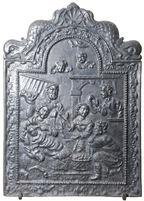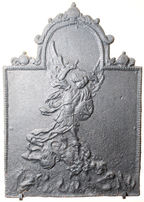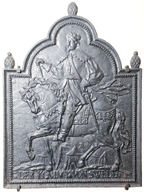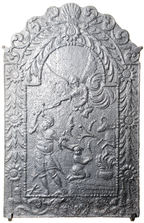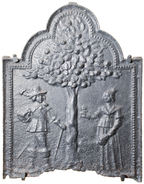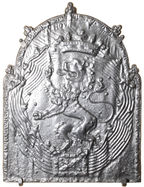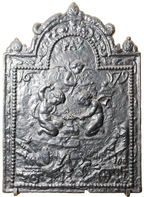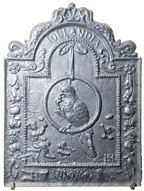-
571
Description: Arched rectangular shaped central panel with bead-on-fillet edging; pictorial scene of the interior of the stable at Bethlehem with a stone arched doorway and a hay stall in the background; in the left foreground the seated figure of the Virgin Mary with the infant Jesus, and Joseph behind; behind Joseph a donkey, and to the left of the child a seated ox; to the right, three figures, one kneeling and another holding a hat; in front of the kneeling figure a basket; arched rectangular border with fillet edging and a repeated leaf pattern; on top, a scallop shell between two dolphins.
Notes: The scene is of the Adoration by the Magi - Matthew 2: 11. Mitford collection, Petworth House.
Copies of this fireback are known.
Manufactured: in the mid- to late-17th century in the Siegerland area of Germany.
Current location: Petworth House, Petworth, West Sussex, England.
Museum number: NT/PET/M/62 (part of the National Trust museum group)
- Attached to series:
- 'Dutch' Miscellaneous Firebacks
- New Testament firebacks
- 'Dutch' Dolphin series
-
572
Description: Arched rectangular shape with bead-on-fillet edging; pictorial scene of St Michael the Archangel fighting the Devil; on top, a pomegranate with serpents descending down each side of the arch; a pomegranate on top of each shoulder of the plate.
Notes: Notable for the absence of a border and the lack of a background to the scene. Mitford collection, Petworth House.
Copies of this fireback are known.
- Decoration tags:
- 'Dutch' (shape)
- bead-on-fillet (edging)
- whole carved pattern
- pictorial
- biblical
- humans
Manufactured: in the mid- to late-17th century in the Siegerland area of Germany.
Current location: Petworth House, Petworth, West Sussex, England.
Museum number: NT/PET/M/63 (part of the National Trust museum group)
- Attached to series:
- 'Dutch' Miscellaneous Firebacks
- New Testament firebacks
-
573
Description: Rectangular with fillet sides and bottom; scrolled foliage on outside edges; date in narrow rectangular panel at bottom; central pictorial representation of four historical figures (see below), three male in mid-17th century armour, and one female; tripple arched top formed of rococo scrolls, a putto forming the middle arch.
Notes: The inscription may relate to the defeat of the Spanish at s'Hertogenbosch (den Bosch - ENDE BUSH) in 1629, and Wesel. von den Driesch states that the figures, from left to right, are: Prinz Fredrik Henrik of Oranje, his daughter, Luise Henriette, Prince Maurice of Nassau, and the Elector Friedrich Wilhelm of Brandenburg, who married Luise Henriette. German craftsmanship may account for the incorrect spelling of Dutch names. Mitford collection, Petworth House.
Copies of this fireback are known.
Inscription: PRESNTZI VAN WESEL ENDE BVSH / 1667
- Decoration tags:
- rectangular with three arches (shape)
- complex individual (edging)
- whole carved pattern
- pictorial
- historical
- royal
- text
- humans
Manufactured: in 1667 possibly in the Siegerland area of Germany.
Current location: Petworth House, Petworth, West Sussex, England.
Museum number: NT/PET/M/64 (part of the National Trust museum group)
- Attached to series:
- 'Dutch' Miscellaneous Firebacks
- Commemorative firebacks
-
574
Description: Arched rectangular central panel with arch and bead edging within a similarly shaped cavetto-moulded border and pomegranates on to and on the ach shoulder of the plate; pictorial representation of the king of Sweden mounted on a horse.
Notes: The king would be Gustav II. There is a companion fireback bearing the image of Prince Fredrik Henrik of Oranje. Mitford collection, Petworth House.
Copies of this fireback are known.
Inscription: DIE KONINCK VON SWEDEN
- Decoration tags:
- rectangular with arch above arch (shape)
- cavetto (edging)
- whole carved pattern
- pictorial
- historical
- royal
- text
- animals
- humans
Manufactured: in the mid- to late-17th century in the Siegerland area of Germany.
Current location: Petworth House, Petworth, West Sussex, England.
Museum number: NT/PET/M/65 (part of the National Trust museum group)
- Attached to series:
- 'Dutch' Miscellaneous Firebacks
- Commemorative firebacks
-
577
Description: Arched rectangular central panel with bead-and-pellet edging; pictorial scene of Abraham about to sacrifice Isaac, the former's hand being stayed by an angel, a ram in an adjacent thicket; arched rectangular border with fillet edging; arrangement of sunflowers linked with festoons of leaves; at bottom, swirled foliage; on top, a scallop shell between mirrored swirled foliage.
Notes: The scene is from the Old Testament - Genesis 22: 12; a popular subject on firebacks. Mitford collection, Petworth House.
Manufactured: in the mid- to late-17th century possibly in the Siegerland area of Germany.
Current location: Petworth House, Petworth, West Sussex, England.
Museum number: NT/PET/M/68 (part of the National Trust museum group)
-
578
Description: Arched rectangular shape with arch; bead-on-fillet edging within a cavetto-moulded border; pictorial representation of a man and woman in the dress of the mid 17th century, with a fruit tree between them.
Notes: The significance of this design has not been satisfactorily explained. Carpentier suggests it may be a contemporary depiction of Adam and Eve. Mitford collection, Petworth House.
Copies of this fireback are known.
- Decoration tags:
- rectangular with arch above arch (shape)
- cavetto (edging)
- whole carved pattern
- pictorial
- humans
Manufactured: in the mid- to late-17th century in the Siegerland area of Germany.
Current location: Petworth House, Petworth, West Sussex, England.
Museum number: NT/PET/M/69 (part of the National Trust museum group)
Citation: Carpentier, H., 1912, Plaques de Cheminées (Paris, published by the author).
- Attached to series:
- 'Dutch' Miscellaneous Firebacks
-
580
Description: Arched rectangular shape with fillet edging and a repeated line and concentric semi-circle design; wicker enclosure with gate at bottom, overlaid with a lion rampant surmounted by a crown.
Notes: The enclosure is the Garden of Holland (Hollandse Tuin) and the lion the badge of the States General of the Netherlands; on the shoulders of the plate, and on three other positions equally spaced around the arch, repeated small fleurs-d-lys. Mitford collection, Petworth House.
Inscription: ...E HOV...
- Decoration tags:
- rectangular with round arch (shape)
- complex individual (edging)
- whole carved pattern
- heraldic
- text
- animals
- objects
Manufactured: in the mid- to late-17th century possibly in the Siegerland area of Germany.
Current location: Petworth House, Petworth, West Sussex, England.
Museum number: NT/PET/M/71 (part of the National Trust museum group)
- Attached to series:
- 'Dutch' Miscellaneous Firebacks
- 'Dutch' Garden of Holland firebacks
-
581
Description: Arched rectangular central panel with arch and bead-on-fillet edging; pictorial representation of a popinjay, or parrot, perched on a ring suspended by a string, the bird is clutching an olive twig, two others are below; arched rectangular border with arch; cavetto-moulded edging;to left and right, a Corinthian column with twisted lower part, and an entablature above; at top, a central flower with scrolls descending on both sides of the arch; on top, n orb, repeated on each shoulder of the plate.
Notes: The inscription is a mis-spelling of the German for parrot; the parrot on the ring perch is a popular design on Dutch firebacks. Mitford collection, Petworth House.
Copies of this fireback are known.
Inscription: PAPEGEI
- Decoration tags:
- rectangular with arch above arch (shape)
- cavetto (edging)
- whole carved pattern
- pictorial
- architectural
- text
- animals
Manufactured: in the mid- to late-17th century in the Siegerland area of Germany.
Current location: Petworth House, Petworth, West Sussex, England.
Museum number: NT/PET/M/72 (part of the National Trust museum group)
- Attached to series:
- 'Dutch' Miscellaneous Firebacks
- 'Dutch' Bird on perch firebacks
-
525
Description: Arched rectangular central panel with bead edging; pictorial scene of two putti bent over a central anvil, with a third putto above; below are martial symbols (cannon, banners etc.); in the arch the word 'PAX', and in the shoulders of the panel, the date in two parts; arched rectangular boreder with fillet edging, and foliage draped from the top; on top, a pomegranate to which ascends a serpent on each side, with a further pomegranate on each shoulder of the plate.
Notes: The scene may be intended to represent the infant Vulcan. Mitford collection, Petworth House.
Inscription: PAX / 16 79
- Decoration tags:
- 'Dutch' (shape)
- fillet (edging)
- whole carved pattern
- individual numbers
- pictorial
- mythological
- text
- humans
- objects
Manufactured: in 1679 possibly in the Siegerland area of Germany.
Current location: Petworth House, Petworth, West Sussex, England.
Museum number: NT/PET/M/79 (part of the National Trust museum group)
- Attached to series:
- 'Dutch' Miscellaneous Firebacks
-
526
Description: Arched rectangular central panel with bead on fillet edging; suspended from the top, by a ribbon, a ring with a popinjay, or parrot perched thereon, biting a twig in its right claw; below left is a seated child, and in the bottom corners the initial and monogram; around this panel is an arched rectangular border with fillet edging, at the top of which is the word, HOLLANDIA, between scrolls, with swags of fruit hung on ribbons suspended from roses down each side; at the bottom, a motto scroll bearing the inscription, ANNO 16 ...; on top, a central scallop shell between two dolphins.
Notes: A common design among firebacks produced in Germany for the Dutch market. Mitford collection, Petworth House.
Copies of this fireback are known.
Inscription: HOLLANDIA / H HS / ANNO 16 ...
- Decoration tags:
- 'Dutch' (shape)
- cavetto (edging)
- whole carved pattern
- pictorial
- allegorical
- monogram
- text
- animals
- humans
- objects
Manufactured: in the mid- to late-17th century in the Siegerland area of Germany.
Current location: Petworth House, Petworth, West Sussex, England.
Museum number: NT/PET/M/70 (part of the National Trust museum group)
- Attached to series:
- 'Dutch' Bird on perch firebacks
